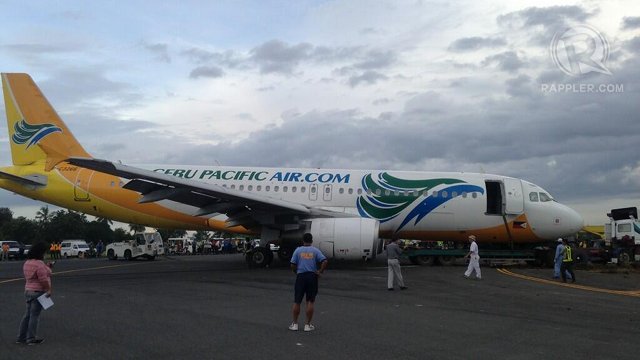SUMMARY
This is AI generated summarization, which may have errors. For context, always refer to the full article.

MANILA, Philippines (UPDATED) – After two days, over 40 cancelled or re-routed flights, and hundreds of stranded passengers, the Davao international airport is back in business.
On Tuesday evening, June 4, the country’s 3rd busiest airport resumed operations after Cebu Pacific towed its Airbus A320-200 aircraft stuck at the airport runway since Sunday evening, June 2.
The Civil Aviation Authority of the Philippines (CAAP) announced that airport operations are back to normal starting at around 8pm.
Check-in counters of legacy carrier Philippine Airlines (PAL) and its unit PAL Express have started processing passengers flying out of Davao.
Cebu Pacific said its Davao flights will be back to normal on Wednesday, June 5.
CAAP deputy director general Capt. John Andrews told ANC that at least 3 flights are expected to arrive in Davao airport Tuesday night. About two PAL flights are about to leave Manila for Davao, while one Zest Air flight is about to land in Mindanao’s main gateway Tuesday night.
CAAP Deputy Director General Rodante Joya said investigation on what caused the Airbus aircraft carrying 165 passengers to skid off the runway after it touched down amid heavy rain will continue.
In an ANC interview, Joya said they have sent the data recorder—also known as the “black box”— of the Manila-Davao flight 5J 971 to Singapore for further investigation.
Previously, CAAP Deputy Director John Andrews said pilot error was the likely cause of the airport mishap since they found nothing wrong with the aircraft engine.
Two days to tow
On Tuesday afternoon, the CAAP issued an order that it would take over the task of pulling out the aircraft from the grassy part of the 3,000-meter-long runway after Cebu Pacific missed the “final deadline” at 3pm.
Citing national interest, CAAP wanted to take over the removal process without regard to the damage they may do to the multi-billion-dollar plane.
CAAP Deputy Director General John Andrews said the process had been painfully slow since Cebu Pacific wanted to salvage the plane so it could still use it. Debates included whether to tow the aircraft from the rear or the front.
The Gokongwei-led airline hired a team of engineers and maintenance personnel from a Singapore company who tried to extract the plane starting Monday. Another team from Airbus also assisted in the extraction.
The crowd cheered when the aircraft was pulled out of the grassy part of the runway and when its nose landing gear touched the paved ground at 4:30 pm Tuesday.
Emergency or not
Andrews also scored Cebu Pacific for not implementing emergency procedures in deplaning the passengers.
He echoed the point of industry veteran Benjamin Solis that the pilots in an emergency situation should have ordered the cabin crew to “immediately evacuate” passengers because it may not be safe to stay inside.
Andrews said the standard operating procedure is to evacuate all passengers within 3 minutes. According to first hand accounts of passengers, they were deplaned after 20 to 30 minutes.
Some of the passengers onboard took to social media to air their harrowing experience.
The incident prompted the president of Ateneo de Davao University to write a scathing letter accusing the airline’s personnel of “insensitivity and ineptness” in dealing with the airline passengers. “It was only after 27 minutes in a smoked cabin that the passengers were allowed to leave the plane by coming down emergency slides,” wrote Fr. Joel E. Tabora.
He also said the university is boycotting Cebu Pacific — the country’s biggest domestic airline operator.
Cebu Pacific vice president Candice Iyog admitted there were possible lapses in how the ground crew handled the affected passengers. “We admit we have something we can improve on,” she said in an interview Tuesday morning.
Lance Gokongwei, Cebu Pacific president and CEO issued a personal apology to the travelers who were affected by the “unfortunate incident. However, he defended cabin crew.
He commended the cabin crew for not panicking and for implementing a “precautionary disembarkation” procedure, which involved opening just the front part and allowing the passengers to slide down.
He said emergency procedures would have caused “injury.”
Gokongwei highlighted that no one was injured from the incident. – Rappler.com
Add a comment
How does this make you feel?
There are no comments yet. Add your comment to start the conversation.